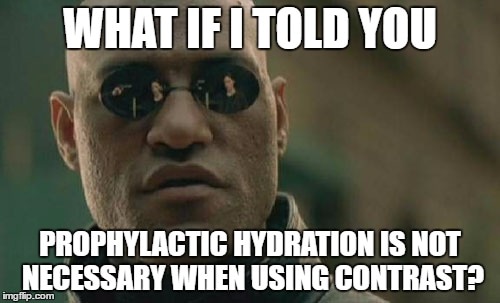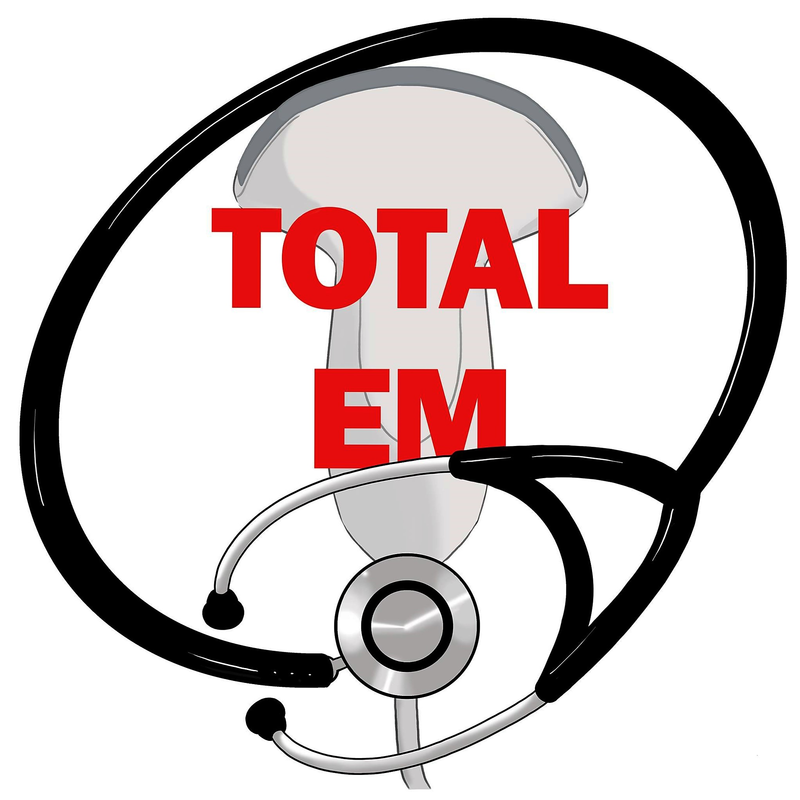|
It may feel like we have been talking about a lot on imaging recently, but in emergency medicine, we do a lot of imaging! More specifically, CTs are a cornerstone in the emergency department and contrast is frequently used. However, there have been concerns about the use of contrast in higher risk populations which we have also discussed before. In patients at higher risk, is prophylactic hydration beneficial? We discuss that on today's podcast with a new randomized control trial.
Title:
Prophylactic hydration to protect renal function from intravascular iodinated contrast material in patients at high risk of contrast-induced nephropathy (AMACING): a prospective, randomised, phase 3, controlled, open-label, non-inferiority trial Case: A 52 y/o male with a history significant for chronic kidney disease and insulin dependent diabetes mellitus comes to your emergency department complaining of chest pain you suspect is from a new onset pulmonary embolism. Per hospital protocol, you obtain routine labs including obtaining an estimated glomerular filtration rate (eGFR) prior to ordering a CT with IV contrast. The eGFR is 48 mL/min/1.73m2 and you remember from previous studies that such as value is not considered to be an independent risk factor for post-contrast acute kidney injury (PC-AKI). He does not appear to need fluid resuscitation and after ordering the CT, the CT tech calls to ask if you plan to give the patient IV fluid hydration prophylactically to protect renal function. Background: Recent literature has been dismantling many of the arguments related to the concerns of PC-AKI and even if contrast induced nephropathy (CIN) is a real concern in the modern age of CT imaging. There are current practice guidelines that support the use of intravenous normal saline to prevent PC-AKI and CIN. Given the lack of effective treatment for these conditions, prevention is the key. However, debate has developed on if this is cost-effective or more importantly clinically effective. Despite being widely recommended in guidelines, no randomized trial has prospectively compared peri-procedural intravenous hydration with normal saline with a group receiving no prophylactic hydration in the high-risk population targeted by the guidelines (including the ESUR, ACR, and NICE). IV fluid hydration is also not without risks. It can lead to symptomatic heart failure due to volume overload, electrolyte abnormalities such as hyponatremia or hypernatremia, and even arrhythmias (all monitored in the study). Another risk with this process is that this could lead to hospitalization of the patients to fulfill the IV fluid protocol, which exposes patients to risks such as hospital-acquired infections. Clinical Question: Is not giving prophylactic hydration non-inferior to standard care prophylactic hydration in regards to the rate of CIN? Reference:
Author’s Conclusions: No prophylaxis was found to be non-inferior and cost saving in preventing contrast-induced nephropathy (CIN) compared with intravenous hydration according to current clinical practice guidelines. Quality Checklist for Randomized Clinical Trials:
Key Results: The mean 2-6 day change in serum creatinine was 0.31 μmol/L in the prophylactic hydration group (SD 13.79), and 1.30 μmol/L in the group without prophylactic hydration (SD 15.09; p=0.4049). An increase of more than 25% or 44 μmol/L increase in serum creatinine from baseline (which was the definition for CIN) was recorded for eight (2.7%) of the 296 patients in the prophylactic hydration group and for eight (2.6%) of 307 patients in the group without prophylactic hydration. The absolute difference in proportions with contrast-induced nephropathy (no hydration vs hydration) was -0.10% (one-sided 95% confidence interval of -2.26 to 2.06 and a one-tailed p=0.4710). The upper limit was below 2.1%, which excludes a difference in favor for the hydration group of more than 2.1%. Key Points of Debate:
Comparing Conclusions: This study has many implications and may further shed light on how we could be managing patients with the more modern contrast media we have today. While many patients in the emergency department may still need IV fluid hydration for other reasons, such as the severity of their illness and needing fluid resuscitation, this study still is important because of how it can improve department flow and avoid admissions that may not otherwise be necessary. Our Bottom Line: We agree that this study demonstrates that no hydration prophylaxis is non-inferior to hydration prophylaxis in regards to the rate of CIN (or more accurately PC-AKI). Case Resolution: You discuss with the CT tech that you do not believe the patient requires prophylactic IV fluid hydration. You briefly mention this new paper and the CT tech suggests that this could also be discussed in the future with the staff radiologist since there is no such protocol currently regarding this evidence. Your patient receives his CT without incident and is found to have a sub-segmental PE. After addressing the patient’s concerns and the PE, he is discharged. On follow-up, his PCP reports no PC-AKI or CIN. Clinical Application: The landscape is constantly evolving in the world of radiology especially in regards to PC-AKI and CIN. It is difficult to say if this myth (or more appropriately a pseudo-axiom) is truly "busted" but it does bring about some important points. In hospitals where there is currently a protocol for IV fluid hydration, this may be one of the pieces or evidence to bring forward regarding how this protocol could potentially change. For those centers without a protocol, this could further establish practice for the future. Ultimately, this will need to be a team-based decision across multiple specialties (such as nephrology and radiology when applicable) to further investigate and agree upon this plan. What do I tell my patient? Due to some of your risk factors such as chronic kidney disease and diabetes, you are traditionally considered to be at a higher risk of complications with regards to contrast being given while receiving a CT. However, recent studies have demonstrated otherwise. One such study is that you may not need to receive IV fluids both before and after you receive your CT. IV fluids are not without risk and can lead to serious complications that could lead to an admission. Based on the most recent evidence, we can consider withholding this prophylaxis as it does not appear to compromise your safety. Conclusion: Thank you for listening to the podcast and reading the blog. Please let us know what you think by giving us feedback here in the comments section or contacting us on Twitter or Facebook. Remember to look us up on Libsyn and on iTunes. If you have any questions you can also comment below, email at [email protected], or send a message from the page. We hope to talk to everyone again soon. Until then, continue to provide total care everywhere.
3 Comments
3/1/2017 08:39:50 am
Thanks! listened to this on the way to work yesterday. Kind of mind blowing....
Reply
Chip Lange, PA-C
3/1/2017 03:45:39 pm
Thanks for sharing your thoughts! It really is mind-blowing in a lot of ways. It's funny you mention the Hinson paper as we had a recent podcast covering it and similar literature in a deep dive. If you are interested check it out here: http://www.totalem.org/emergency-professionals/podcast-28-deep-dive-on-safety-of-iv-contrast-in-cts-with-paul-schunk
Reply
5/26/2022 06:30:55 am
this post is quite helpful to read which is amazing to read thanks for sharing this detailed please sharing this type of posts.
Reply
Leave a Reply. |
Libsyn and iTunesWe are now on Libsyn and iTunes for your listening pleasure! Archives
August 2022
Categories |
||||||


 RSS Feed
RSS Feed